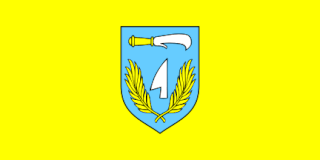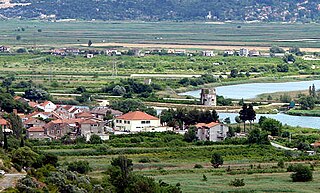
Donji Lapac is a settlement and a municipality in Lika, Croatia.

Petlovac is a village and municipality in the western part of Baranja, which comprise the northern part of Osijek-Baranja County in Croatia. Petlovac is underdeveloped municipality which is statistically classified as the First Category Area of Special State Concern by the Government of Croatia.

Srb is a village located in the southeastern part of Lika, in Croatia, till 2011 administratively divided into Donji Srb and Gornji Srb. Srb lies in the Una River valley, on the road from Donji Lapac to Knin, and is east of Gračac. It is currently part of the Gračac municipality and the Zadar County.

Kula Norinska is a village and a municipality in the Dubrovnik-Neretva County in southeastern Croatia.

Desne is one of nine villages of the Municipality of Kula Norinska, in the Dubrovnik-Neretva County, on Croatia's Dalmatian coast.
Novo Nevesinje is a settlement in the region of Baranja, Croatia. Administratively, it is located in the Petlovac municipality within the Osijek-Baranja County. Population is 63 people.
Knešpolje is a settlement within the municipality of Široki Brijeg, Bosnia and Herzegovina. In 1991, the settlement had a population of 1,110. It is located along the Mostar-Široki Brijeg roadway.
Brotnja is a village in Croatia. It is connected by the D218 highway.
Boričevac is a village in Croatia.
Zaklopac is a village in Croatia.
Cerovac is a village in Croatia.
Kijani is a village in the Gračac municipality in Croatia.
Omsica is a village in Croatia.
Krstatice
is a village in the Split-Dalmatia County, Croatia located in the Zagvozd municipality. In 2011 it was populated by 123 inhabitants.
Rašćane Gornje is a village in the Split-Dalmatia County, Croatia located in the Zagvozd municipality. In 2011 it was populated by 19 inhabitants.
Rastovac is a village in the Split-Dalmatia County, Croatia located in the Zagvozd municipality. In 2011 it was populated by 168 inhabitants.
Župa is a village in the Split-Dalmatia County, Croatia located in the Zagvozd municipality. In 2011 it was populated by 53 inhabitants.
Župa Srednja is a village in the Split-Dalmatia County, Croatia located in the Zagvozd municipality. In 2011 it was populated by 3 inhabitants.

Borovci is a village near Metković in the Kula Norinska municipality with a population of 29.

Krvavac is a village in the Kula Norinska municipality.










